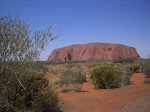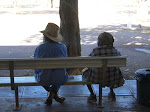Early Aboriginal Paintings From Papunya
In 1971, a teacher named Geoffrey Bardon, working with indigenous Australians in the remote settlement of Papunya, near the center of the continent, had an idea that you wouldn’t have expected to bear fruit beyond the region.
He provided a group of elderly and middle-aged men with acrylic paints and pieces of Masonite and suggested that they make paintings based on their own aesthetic and spiritual traditions.
Grey Art Gallery
Shorty Lungkarta Tjungurrayi’s “Mystery Sand Mosaic” (1974).
Accustomed to painting their bodies and ceremonial objects and making temporary sand mosaics, the men took to the new materials brilliantly. Improbably, a new movement was born, and within a few years paintings made by Aboriginal artists from across Australia had become an international phenomenon. Western collectors bought them, museums and galleries exhibited them, and a giant tourist industry grew up around them.
The fad for Aboriginal painting was off-putting. Certainly the works were visually catchy: with their bold, diagrammatic compositions, finely coordinated colors and dotted patterns they appealed to Western eyes trained to respond to abstraction and folk and outsider art. But there were questions about authenticity and the exploitation of indigenous artists.
In 2006 the Australian Senate investigated allegations that non-Aboriginals were cranking out some of the paintings and that others were being made by Aboriginals working under sweatshop conditions, and found much cause for concern.
Given this problematic background you could be forgiven for approaching “Icons of the Desert: Early Aboriginal Paintings From Papunya” at the Grey Art Gallery warily. But if you skip it you miss a beautiful show.
Organized by the Australian art historian Roger Benjamin for the Herbert F. Johnson Museum of Art at Cornell University, it presents about 50 paintings, most made where it all began, in Papunya in the early ’70s. All are from the collection of the New Yorkers John and Barbara Wilkerson, who began acquiring Aboriginal paintings in 1994. Focusing on the earliest works — those known as Papunya boards — they wisely avoided possibly dubious material that might have been produced only for the ravenous market.
Although the iconography and graphic vocabulary the Papunya artists used were more than 10,000 years old, their paintings have the visual impact of Modern abstractions. With a deft, sensuously immediate touch, the artists typically activated flat, frontal designs with dense patterns of dots, stripes and concentric circles and squares. There is a familial resemblance among most of the paintings; at first the exhibition looks like the work of one collective consciousness. But with extended viewing, differences emerge.
Johnny Warangkula Tjupurrula’s “Water Dreaming at Kalipinypa” (1972), a panel approximately 2 ½ feet square covered with a patchwork pattern of fine white hatch marks and dotted and concentric circles, is a work of breathtaking subtlety. It’s like an aerial view of farmland and forests lightly dusted by snow.
By contrast, in Shorty Lungkarta Tjungurrayi’s “Mystery Sand Mosaic” (1974), in which four sausage-shaped forms seem to be standing at the edge of a well, dotted concentric bands radiating around the dark center are rendered in incandescently bright hues.
After the introduction of Masonite panels, other art teachers brought canvas and stretchers to Papunya, enabling the painters to create larger works. The exhibition’s earliest painting on canvas is one from 1974 by Mr. Tjungurrayi. On an approximately 5 ½-by-3 ½-foot surface, he painted scores of overlapping whorls of different sizes in reds, yellows and pinks. The forms come out at you with exuberant energy, like sounds from a jazz orchestra.
Often, differently patterned layers create fascinating spatial complexities. Made on a slightly off-square panel with cut-off corners, Clifford Possum Tjapaltjarri’s “Women’s Dreaming About Bush Tucker ‘Yarlga’ ” (1972) has dotted, cloudlike formations partly obscuring a center of white concentric circles and radiating spokes. It too gives the impression of an aerial photograph, this one of a secret military installation. According to the catalog, the painting represents women sitting around a campfire; “bush tucker” is the Australian term for the various sorts of food that Aboriginals foraged for; “yarlga” is an onionlike comestible.
As that interpretive note on Mr. Tjapaltjarri’s painting suggests, there is a major dimension to Aboriginal works that will be lost on most viewers: what they meant and represented to the artist. When asked about the significance of different forms in their paintings, the Papunya artists (most of whom have since died) explained that they referred to waterholes, streams, food sources, landscapes, totemic animals, ancestors, mythic beings, rituals, “songlines” and so on. In other words, far from merely decorative, the paintings represent highly elaborated cosmologies.
But because of language barriers and reluctance on the part of artists to divulge much about their sacred traditions, interpretations offered in wall labels and in the catalog remain partial and speculative. Moreover, the Aboriginal cast of mind is so different from that of the West that even the most extensive explanations can be mystifying. “The Dreaming,” a recurring subject in Aboriginal paintings that has to do with the origins of the world, is a pretty hard concept to grasp for a viewer raised on French Enlightenment-style reasoning.
At the doorway leading to the Grey’s downstairs gallery, a wall label warns away Aboriginal women and children should any happen to be visiting. Two of the paintings below are the only ones in the show depicting people, but none in the lower-level group are any more compelling than the ones upstairs. They are restricted because they represent information that only male initiates are traditionally allowed to know. They are also believed to be inhabited by dangerously powerful supernatural entities. Secularized Westerners don’t think art can have that kind of potency, but who knows, maybe that is our loss.
“Icons of the Desert: Early Aboriginal Paintings From Papunya” is on view through Dec. 5 at the Grey Art Gallery, New York University, 100 Washington Square East, Greenwich Village; (212) 998-6780, nyu.edu/greyart.
Material for this post comes from: Painting the Ancient, Invisible Dream - Art Review | 'Icons of the Desert' By KEN JOHNSON Published: October 1, 2009 New York Times
~~~~~ ~~~~~ ~~~~~ ~~~~~ ~~~~~ ~~~~~ ~~~~~ ~~~~~

Artlandish Aboriginal Art Gallery is proud to showcase to the World one of the largest and most comprehensive on line Galleries of Authentic Australian Aboriginal Art and Artefacts. Enjoy the wonderful talent of the artists presented, which reflects their country and a culture which is timeless.
Money Back Guarantee Over 1000 Artworks Online
Complimentary Worldwide shipping and insurance applies to all Aboriginal artworks & artefacts purchased through Artlandish.
















No comments:
Post a Comment